engine JAGUAR XJ 2004 X350 / 3.G Owner's Manual
[x] Cancel search | Manufacturer: JAGUAR, Model Year: 2004, Model line: XJ, Model: JAGUAR XJ 2004 X350 / 3.GPages: 227, PDF Size: 4.22 MB
Page 114 of 227

On the Road 4 - 43
To Stop the Engine and Lock
the Steering
Turn the key from position ‘II’ to the
‘lock’ position ‘0’. This turns off the
ignition and stops the engine.
The steering will be locked when the key
is removed from the switch.
Leaving the key in position ‘I’ or ‘II’ will
discharge the battery.
Automatic Transmission
The ‘J’-gate gear selector lever is designed
to accommodate two different driving
techniques as follows:
• Automatic selection – the right-hand side of the selector gate.
• Manual selection – the left-hand side of the selector gate to individually
select 5th, 4th, 3rd, or 2nd gear.
Gearshift Interlock
A brake pedal/gearshift interlock system
is incorporated in the automatic gear
selector mechanism.
To move the gear selector from Park:
1. Turn the ignition key to position ‘II’ or start the engine.
2. Press the brake pedal.
3. Move the lever from Park.
Gear Selector Positions
!WARNING:
The parkbrake or brake pedal must
be applied before selecting forward
or reverse drive from a stationary
position.
P = Park – Use when parking. In this
position the transmission is locked.
Do not select if the vehicle is moving.
N = Neutral – Disconnects the driveline
from the engine. Use the parkbrake when
stopping temporarily.
Page 115 of 227
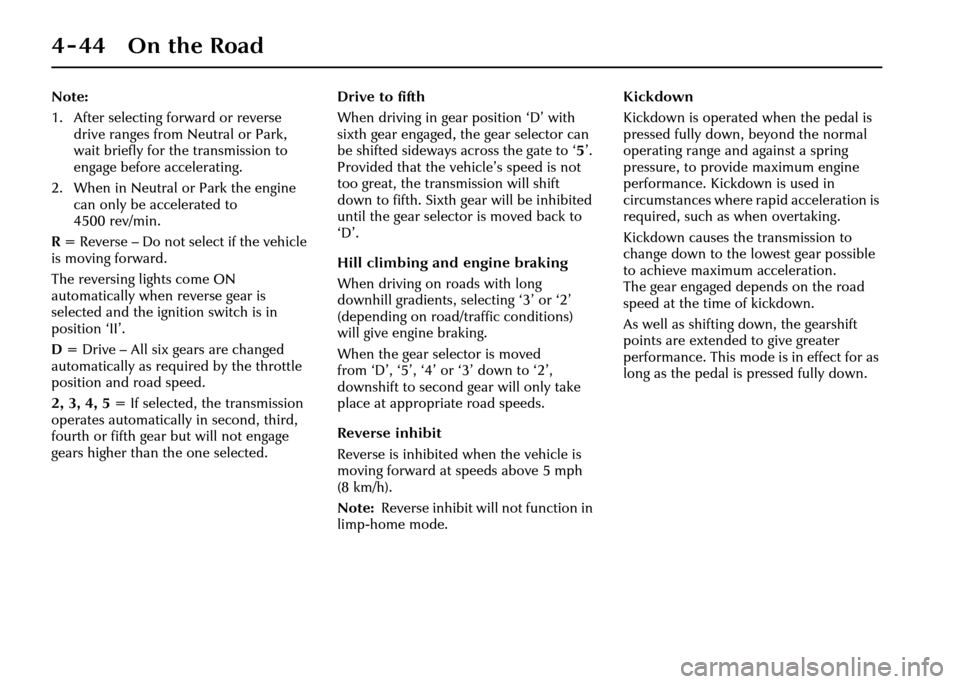
4-44 On the Road
Note:
1. After selecting forward or reverse drive ranges from Neutral or Park,
wait briefly for th e transmission to
engage before accelerating.
2. When in Neutral or Park the engine can only be a ccelerated to
4500 rev/min.
R = Reverse – Do not select if the vehicle
is moving forward.
The reversing lights come ON
automatically when reverse gear is
selected and the ignition switch is in
position ‘II’.
D = Drive – All six gears are changed
automatically as required by the throttle
position and road speed.
2, 3, 4, 5 = If selected, the transmission
operates automatically in second, third,
fourth or fifth gear but will not engage
gears higher than the one selected. Drive to fifth
When driving in gear position ‘D’ with
sixth gear engaged, the gear selector can
be shifted sideways across the gate to ‘
5’.
Provided that the vehicle’s speed is not
too great, the transmission will shift
down to fifth. Sixth gear will be inhibited
until the gear selector is moved back to
‘D’.
Hill climbing and engine braking
When driving on roads with long
downhill gradients, selecting ‘3’ or ‘2’
(depending on road/traffic conditions)
will give engine braking.
When the gear selector is moved
from ‘D’, ‘5’, ‘4’ or ‘3’ down to ‘2’,
downshift to second ge ar will only take
place at appropriate road speeds.
Reverse inhibit
Reverse is inhibited when the vehicle is
moving forward at speeds above 5 mph
(8 km/h).
Note: Reverse inhibit will not function in
limp-home mode. Kickdown
Kickdown is operated when the pedal is
pressed fully down, beyond the normal
operating range and against a spring
pressure, to provide maximum engine
performance. Kickdown is used in
circumstances where rapid acceleration is
required, such as when overtaking.
Kickdown causes the transmission to
change down to the lowest gear possible
to achieve maximum acceleration.
The gear engaged depends on the road
speed at the time of kickdown.
As well as shifting
down, the gearshift
points are extended to give greater
performance. This mode is in effect for as
long as the pedal is pressed fully down.
Page 116 of 227
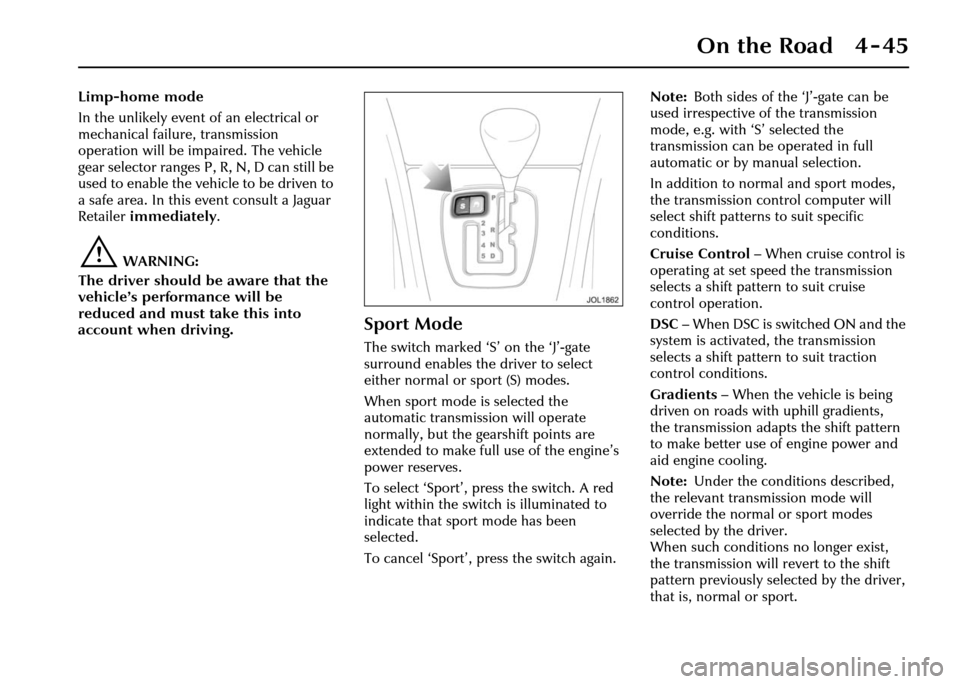
On the Road 4 - 45
Limp-home mode
In the unlikely event of an electrical or
mechanical failure, transmission
operation will be impaired. The vehicle
gear selector ranges P, R, N, D can still be
used to enable the vehicle to be driven to
a safe area. In this event consult a Jaguar
Retailer immediately.
!WARNING:
The driver should be aware that the
vehicle’s performance will be
reduced and must take this into
account when driving.
Sport Mode
The switch marked ‘S ’ on the ‘J’-gate
surround enables the driver to select
either normal or sport (S) modes.
When sport mode is selected the
automatic transmission will operate
normally, but the ge arshift points are
extended to make full use of the engine’s
power reserves.
To select ‘Sport’, press the switch. A red
light within the switch is illuminated to
indicate that sport mode has been
selected.
To cancel ‘Sport’, press the switch again. Note:
Both sides of the ‘J’-gate can be
used irrespective of the transmission
mode, e.g. with ‘S’ selected the
transmission can be operated in full
automatic or by manual selection.
In addition to norm al and sport modes,
the transmission control computer will
select shift patterns to suit specific
conditions.
Cruise Control – When cruise control is
operating at set speed the transmission
selects a shift pattern to suit cruise
control operation.
DSC – When DSC is switched ON and the
system is activated, the transmission
selects a shift pattern to suit traction
control conditions.
Gradients – When the vehicle is being
driven on roads with uphill gradients,
the transmission adapts the shift pattern
to make better use of engine power and
aid engine cooling.
Note: Under the conditions described,
the relevant transmission mode will
override the normal or sport modes
selected by the driver.
When such conditions no longer exist,
the transmission will revert to the shift
pattern previously selected by the driver,
that is, normal or sport.
Page 117 of 227

4-46 On the Road
Dynamic Stability
Control (DSC)
Unless it has been switched off, dynamic
stability control is operational whenever
the engine is running. If the system is
operating, the warning light in the
instrument cluster will flash.
The DSC system controls the anti-lock
braking system (ABS), traction control
and yaw control of the vehicle.Yaw control determines the vehicle’s
direction relative to
the driver’s inputs
(sideslip and under/ov ersteer). It applies
braking pressure to individual wheels if
excessive variation is detected.
This ensures that the vehicle follows the
driver’s intended direction of travel.
Traction control will intervene to reduce
wheel spin, by automatically reducing the
power output from the engine and
applying braking to individual wheels.
This improves acceleration, particularly
on surfaces with uneven friction,
for example, one wheel on ice the other
on tarmac.
ABS helps to prevent the road wheels
from locking and skidding during
emergency braking.
When the system is operating,
the warning light in the instrument
cluster will flash.
The dynamic stability control system can
be switched OFF by pressing the switch
on the centre console switchpack.
The warning light in the instrument
cluster will remain on and a message will
be shown to indicate that the system has
been switched OFF. If the switch is
pressed again the system will switch ON. Note:
If cruise control is engaged it will
automatically disengage if stability control
activates.
A system malfunction is indicated by the
message:
DSC NOT AVAILABLE
Warning light: Amber .
and the instrument cluster DSC warning
light will be lit.
It is safe to drive the vehicle but the
system may not activate under wheel spin
or slide conditions. Report the fault to a
Jaguar Retailer as soon as possible.
!WARNING:
1. The fact that the vehicle is fitted with Dynamic Stability Control
must never allow th e driver to be
tempted into taking risks which
could affect his/her safety or that
of other road users. In all cases it
remains the driver’s responsibility
to drive safely according to the
prevailing conditions.
2. It is recommended that when using snow chains, DSC should be
switched OFF.
Page 121 of 227

4-50 On the Road
Caution:
1. RESUME should only be used if the driver is aware of the set speed
and intends to return to it.
2. It is not recommended to resume set speed when a low gear is
selected as ex cessive engine
speeds will occur.
Cruise Control Will Switch Off
and Clear the Memory When:
• The ignition is switched to position ‘0’.
• A fault occurs. The cruise control system will switch OFF and cannot be
used until the fault is cleared.
Cruise Control Automatic
Switch Off
Cruise control will switch off but the set
speed will remain in the memory when:
• The CANCEL button is pressed.
• The brake pedal is pressed.
• The parkbrake is applied.
• Speed falls below 16 mph (26 km/h).
• Neutral, Park or Reverse gear positions are selected.
• DSC is operating.
• The difference between the actual and set speed is too great.
• When the vehicle reaches a maximum
speed of 144 mph (230 km/h).
• The accelerator pedal is used to accelerate beyond the set speed for
too long a period.
Page 127 of 227
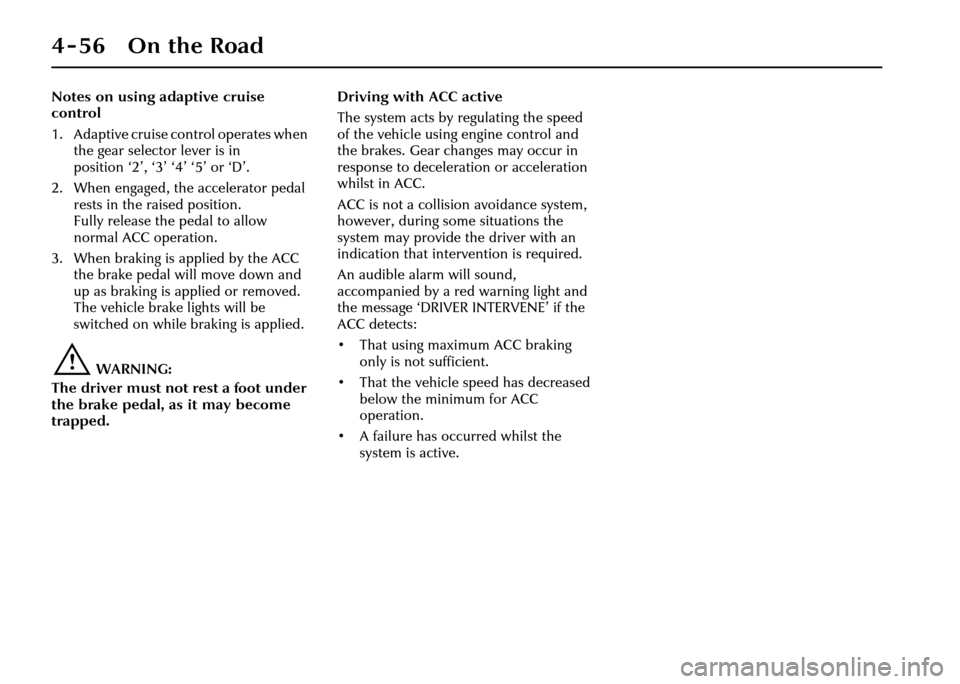
4-56 On the Road
Notes on using adaptive cruise
control
1. Adaptive cruise control operates when the gear selector lever is in
position ‘2’, ‘3’ ‘4’ ‘5’ or ‘D’.
2. When engaged, the accelerator pedal rests in the raised position.
Fully release the pedal to allow
normal ACC operation.
3. When braking is applied by the ACC
the brake pedal will move down and
up as braking is applied or removed.
The vehicle brake lights will be
switched on while braking is applied.
!WARNING:
The driver must not rest a foot under
the brake pedal, as it may become
trapped. Driving with ACC active
The system acts by regulating the speed
of the vehicle using engine control and
the brakes. Gear changes may occur in
response to decelerati
on or acceleration
whilst in ACC.
ACC is not a collision avoidance system,
however, during some situations the
system may provide the driver with an
indication that intervention is required.
An audible alarm will sound,
accompanied by a re d warning light and
the message ‘DRIVER INTERVENE’ if the
ACC detects:
• That using maximum ACC braking only is not sufficient.
• That the vehicle speed has decreased below the minimum for ACC
operation.
• A failure has occurred whilst the system is active.
Page 129 of 227
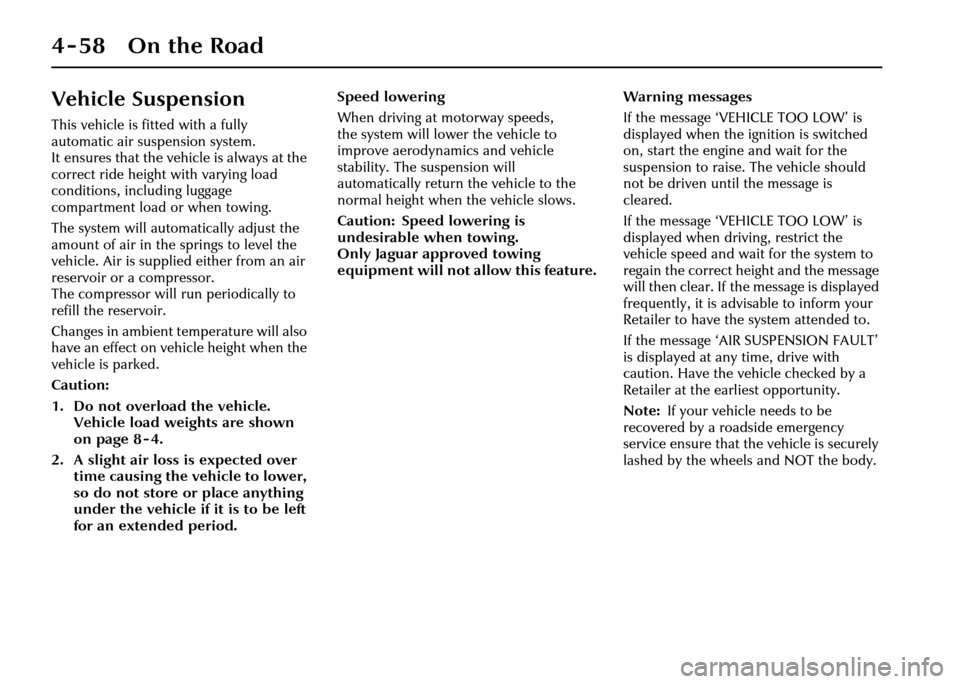
4-58 On the Road
Vehicle Suspension
This vehicle is fitted with a fully
automatic air suspension system.
It ensures that the vehicle is always at the
correct ride height with varying load
conditions, including luggage
compartment load or when towing.
The system will automatically adjust the
amount of air in the springs to level the
vehicle. Air is supplied either from an air
reservoir or a compressor.
The compressor will run periodically to
refill the reservoir.
Changes in ambient temperature will also
have an effect on vehicle height when the
vehicle is parked.
Caution:
1. Do not overload the vehicle. Vehicle load weights are shown
on page 8 - 4.
2. A slight air loss is expected over time causing the vehicle to lower,
so do not store or place anything
under the vehicle if it is to be left
for an extended period. Speed lowering
When driving at motorway speeds,
the system will lower the vehicle to
improve aerodynamics and vehicle
stability. The suspension will
automatically return the vehicle to the
normal height when the vehicle slows.
Caution: Speed lowering is
undesirable when towing.
Only Jaguar approved towing
equipment will not allow this feature.
Warning messages
If the message ‘VEHICLE TOO LOW’ is
displayed when the ignition is switched
on, start the engine and wait for the
suspension to raise. The vehicle should
not be driven until the message is
cleared.
If the message ‘VEHICLE TOO LOW’ is
displayed when driv
ing, restrict the
vehicle speed and wait for the system to
regain the correct height and the message
will then clear. If the message is displayed
frequently, it is advisable to inform your
Retailer to have the system attended to.
If the message ‘AIR SUSPENSION FAULT’
is displayed at any time, drive with
caution. Have the vehicle checked by a
Retailer at the earliest opportunity.
Note: If your vehicle needs to be
recovered by a roadside emergency
service ensure that the vehicle is securely
lashed by the wheels and NOT the body.
Page 130 of 227
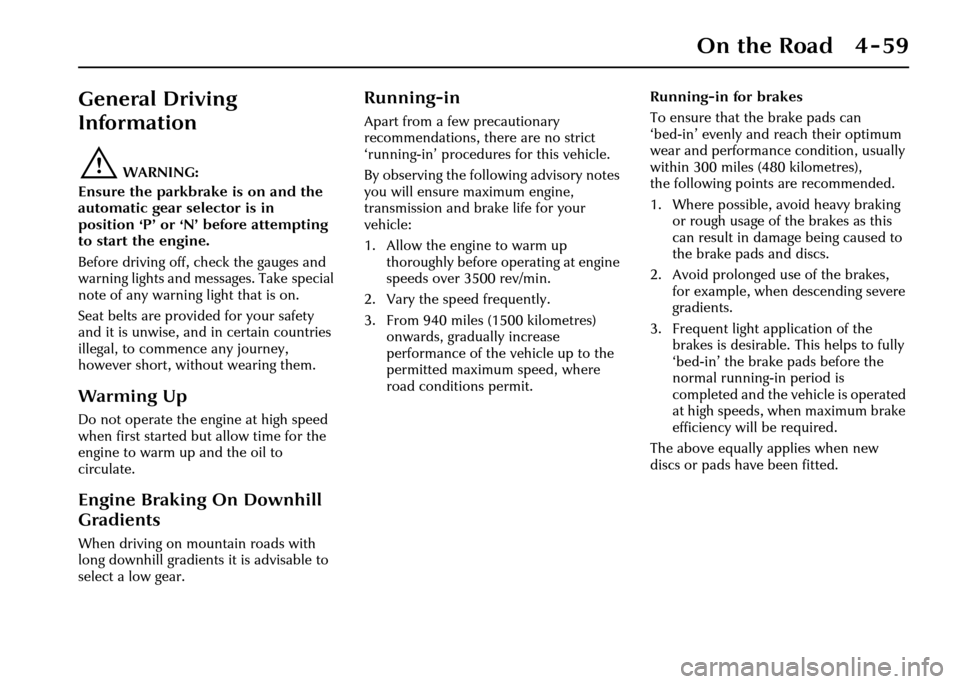
On the Road 4 - 59
General Driving
Information
!WARNING:
Ensure the parkbrake is on and the
automatic gear selector is in
position ‘P’ or ‘N’ before attempting
to start the engine.
Before driving off, check the gauges and
warning lights and messages. Take special
note of any warning light that is on.
Seat belts are provided for your safety
and it is unwise, and in certain countries
illegal, to commence any journey,
however short, without wearing them.
Warming Up
Do not operate the en gine at high speed
when first started but allow time for the
engine to warm up and the oil to
circulate.
Engine Braking On Downhill
Gradients
When driving on mountain roads with
long downhill gradients it is advisable to
select a low gear.
Running-in
Apart from a few precautionary
recommendations, there are no strict
‘running-in’ procedures for this vehicle.
By observing the following advisory notes
you will ensure maximum engine,
transmission and brake life for your
vehicle:
1. Allow the engine to warm up thoroughly before operating at engine
speeds over 3500 rev/min.
2. Vary the speed frequently.
3. From 940 miles (1500 kilometres) onwards, gradually increase
performance of the vehicle up to the
permitted maximum speed, where
road conditions permit. Running-in for brakes
To ensure that the brake pads can
‘bed-in’ evenly and reach their optimum
wear and performance condition, usually
within 300 miles (480 kilometres),
the following points are recommended.
1. Where possible, avoid heavy braking
or rough usage of the brakes as this
can result in damage being caused to
the brake pads and discs.
2. Avoid prolonged use of the brakes, for example, when descending severe
gradients.
3. Frequent light application of the brakes is desirable. This helps to fully
‘bed-in’ the brake pads before the
normal running-in period is
completed and the vehicle is operated
at high speeds, when maximum brake
efficiency will be required.
The above equally applies when new
discs or pads have been fitted.
Page 131 of 227

4-60 On the Road
Use of Headlamps In Daylight
When visibility is poor the headlamps
with dipped beam setting should be
switched on so that the vehicle may be
seen more easily by other road users.
The instrument illumination dimmer
control adjusts the brightness of the panel
lighting.
Engine Oil Consumption
A certain amount of oil consumption is
normal. The rate of consumption will
depend on the following:
• The quality and viscosity of the oil.
• The amount of oxidation and dilution of the oil.
• Climatic conditions.
• The speed at which the engine is being operated.
• Road conditions.
Drivers should expect above normal
consumption when the engine is new,
and after running-in if high speeds are
sustained.
Winter Driving
Freeing a frozen door lock
Caution: Do not ap ply a proprietary
lock de-icer through the keyhole.
Should the lock beco me frozen, warm the
end of the key before use.
Windscreen wiper blades
Before driving away, clear any ice from
the windscreen and check that the wiper
blades are free. Switching on the heated
screen will accelerate this process.
The heated wiper park, if fitted, will come
on automatically.
Frost precautions
The correct concentration of coolant
must be maintained at all times when
‘topping up’ or ‘refilling’ the cooling
system.
Parking the Vehicle
When leaving the vehicle, remember the
following:
• Whenever the vehicle is being parked, apply the parkbrake and move the
gear selector to Park ‘P’.
• Do not leave children or pets in the vehicle unattended.
• Do not leave luggage or valuables on view. Always take your valuables with
you or lock them in the luggage
compartment.
• Remove the ignition key and spare keys, even when the vehicle is in your
garage.
• When the vehicle is unoccupied, close
all windows and lock all doors
securely.
• Park the vehicle where it can be seen. At night, park in a well-lit area.
• Ensure that the keys and the key transmitters are removed from the
vehicle before locking the doors,
and that all doors, the luggage
compartment and the hood are
closed.
Page 133 of 227

4-62 On the Road
Towing a Trailer
Your Jaguar Retailer, and the main
motoring organisations can advise you on
towing, towing weight capacities and
about regulations that apply in other
countries.
The following are important points of
safety, stability and comfort upon which
further advice should be sought:
• Maximum braked towing weight is permissible, provided long periods of
uphill driving on gradients over 8%
are not undertaken.
• In high altitude mountainous regions, the thinner atmosphere can reduce
engine performance. Above 3280 feet
(1000 metres) the stipulated
maximum permitted gross train
weight must be reduced by 10% for
every 3280 feet (1000 metres) in
altitude.
• The kerbside weight of the vehicle can be found on page 8 - 4.
• When towing at the maximum permissible rear axle load keep within
legal towing speeds but in any case do
not exceed 62 mph (100 km/h). • Tyres must be inflated to the normal
(higher) pressures shown on the tyre
pressure label on the fuel filler flap.
• The recommended maximum tow-ball nose weight is shown
on page 8 - 5. Having a lower nose
weight or exceeding the maximum
nose weight limit may impair the
vehicle’s handling.
• When towing, the nose weight of the trailer and the tow-bar assembly must
be deducted from the permissible
maximum load, see page 8 - 5.
• Avoid heavy braking. As the overrun brake on the traile r is not connected
to the ABS, heavy trailer braking
could critically affect the stability of
the outfit as a whole.
• Ensure that the towing vehicle’s engine, transmission, suspension,
brakes and tyres are fully efficient and
regularly serviced. Similarly check the
wheels, tyres, brakes and wheel
bearings of the trailer. Caution:
1. When not in use, it is
recommended that the removable
tow-ball is either securely stowed
in the luggage compartment or,
preferably, not in the vehicle.
Do not leave it loose in the
vehicle.
2. It is essential that only a Jaguar tow-bar and Jaguar electrical tow-
bar kit are supplied and fitted by a
Jaguar Retailer. Contact your
Jaguar Retailer for details of
additional parts that are advised
to be fitted before towing. This is
particularly important with this
vehicle having air suspension.
If unapproved towing equipment
is used whilst towing, the air
suspension speed lowering
function will not be inhibited.
This may result in a change in
trailer weight distribution and
attitude.